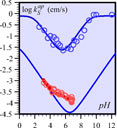Publication
647
PNAS
106, 11829 -11836, 2009.
DOI: 10.1073/pnas.0905020106
|
|
|
|
|
 |
Concerted proton-coupled electron transfers in aquo/hydroxo/oxo metal complexes: Electrochemistry of [OsII(bpy)2py(OH2)]2+ in water. |
|
|
|
|
|
Cyrille Costentin, Marc Robert, Jean-Michel Savéant, and Anne-Lucie Teillout
Laboratoire d‘Electrochimie Moléculaire, UMR CNRS 7591 Université Paris Diderot, 2 place Jussieu 75251 Paris Cedex 05 (France)
Kinetic analysis of the successive oxidative cyclic voltammetric responses of [OsII(bpy)2py(OH2)]2+ in buffered water, together with determination of H/D isotope effects, has allowed the determination of the mechanisms of
the successive proton-coupled electron transfers that convert the OsII-aquo complex into the OsIII-hydroxo complex and the later into the OsIV-oxo complex. The stepwise pathways prevail over the concerted pathway in the first case. However, very large concentrations
of a base, such as acetate, trigger the beginning of a concerted reaction. The same trend appears, but to a much larger extent,
when high local concentration of carboxylates are attached close to the Os complex. The OsIII-hydroxo/OsIV-oxo couple is globally much slower and concerted pathways predominate over the stepwise pathways. Water is, however, not
an appropriate proton acceptor in this respect. Other bases, such as citrate or phosphate, are instead quite effective for
triggering concerted pathways. Here, we suggest factors causing these contrasting behaviors, providing a practical illustration
of the prediction that concerted processes are an efficient way of avoiding high-energy intermediates. Observation of a strong
decelerating effect of inactive ions together with the positive role of high local concentrations of carboxylates to initiate
a concerted route underscores the variety of structural and medium factors that may operate to modulate and control the occurrence
of concerted pathways. These demonstrations and analyses of the occurrence of concerted pathways in an aquo–hydroxo–oxo series
are expected to serve as guidelines for studies in term of methodology and factor analysis. |

